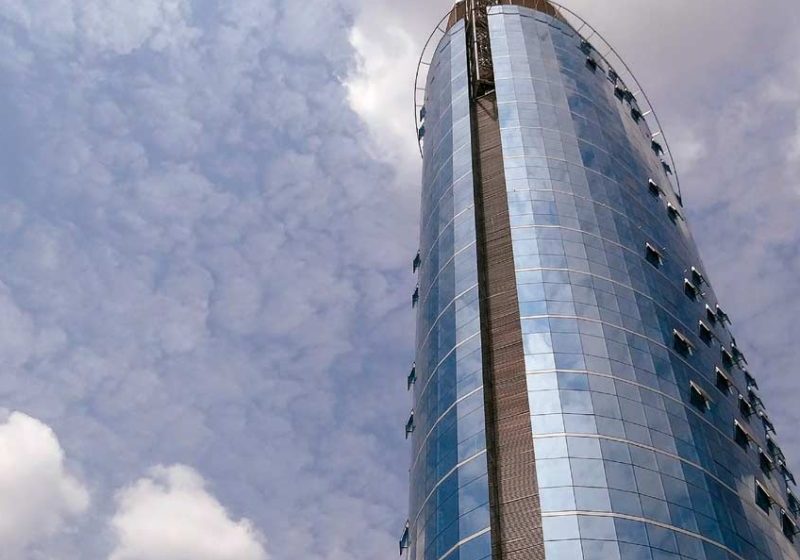IAEC Forum 2019
Jul 1, 2019

Reno, Nevada, proves a great location for the consultant association’s most popular event yet.
The International Association of Elevator Consultants (IAEC) descended on Reno, Nevada, from April 30-May 1 for a productive IAEC Forum. This year’s event at the Renaissance Reno Downtown Hotel was packed with activities and participants, with 41 consultants and 73 vendors attending, and 27 companies taking part in a small exposition.
Things kicked off on April 30 with a NAESA International educational seminar by NAESA Education Director Jack Day that provided 0.8 Continuing Education Units for QEIs. The opening reception that evening was a great chance to meet new industry people and catch up with friends while visiting the well-stocked vendor booths.
The next morning, IAEC Executive Director Sheila Swett opened with fun and quirky facts about Reno, adding that this was the largest convention the hotel had ever hosted. She introduced IAEC President John W. Koshak, who is also on the Elevator World, Inc. Board of Directors. He presented the company’s presentation, “State of the Elevator Industry.” The many facts and predictions were well received, and (as with the other presentations) an active question-and-answer session followed.
Mark Yako of GAL, a member of the Vantage family of companies, then presented “Linear Vs. Harmonic Door Operators,” which looked at the choice from several angles. The first was historical, which revealed the harmonic operator’s inception as a low-torque, low-speed DC solution to code- mandated kinetic energy restrictions. Now with AC and variable-voltage, variable-frequency (VVVF) drives, the style has many advantages but requires more experience to install and has more moving parts. Linear operators may have more disadvantages, but they have seen many improvements over the years and often remain good value purchases. Yako gave a list of questions to ask when choosing between them and advised on which application is right for each.
Next, Pat Dreps of Brugg Lifting presented “CTP: Coated Traction Products — A Milestone in Elevator Rope Technology,” an interesting presentation on new developments in suspension means and a perfect fit for this month’s Focus Topic (p. 92).
Tom Reamsnyder of Virginia Controls then presented “The Advantage of a Complete Control System Package,” sharing advantages of a complete controller system package from a single source. Another presentation steeped in history, it provided a comprehensive look at controller packages from their inception more than 25 years ago until today. It also looked to the future and weighed in on the side of nonproprietary equipment in its battle with proprietary options.
Tim Ebeling of Henning spoke on the detection of wear using intelligent sensors in “Lifting Elevators Into the Cloud!” The audience learned how his company is using sensors for “true predictive maintenance” in the WEARwatcher System for both new installations and modernizations. With a full suite of sensors, the technology gathers nearly 200 parameters per trip, monitoring shaft efficiency, acceleration, vibrations, load, door condition, leveling and rope condition. Testing data is also obtained. One groundbreaking aspect, he argued, is that since the system looks at trends (curves), it does not need the most accurate data and most expensive sensors.
Ebeling promised, “There will be a huge change in our industry” with maintenance contracts making elevator service companies liable for unavailability of the elevators with very high availability rates (such as 99%) required. In 10-15 years, we will see Internet of Things devices on all elevators, he added.
Alice Gogh and Michael O’Hagan of Captivate then spoke on “Enhancing the Tenant Experience: The Power of a Turnkey Solution.” It promoted the effectiveness of digital signage, which is expected to reach a market exceeding US$7 billion by 2025. A study showed it can increase retail sales by 30% and increase customer storefront entries by 76%. In elevators, 90% of passengers watch digital information for the entirety of their rides. Captivate’s Connect Series partners with CE Electronics, MAD Elevator and KONE for content sharing.
Peter McIntosh of motor/machine rebuilder McIntosh Industries and Andy Hawkinson of drive manufacturer Magnetek then spoke on “PWM Drives & DC Machine Interaction — Successful Modernization Preparation.” Good reasons to retain DC gearless machines were covered, and pulse-width-modulated (PWM), silicon-controlled-rectifier and motor-generator-set drives were compared. They explained that PWM drives help DC motors remain useful and efficient, even in their old age, with performance comparable to that of modern AC VVVF drives. They also suggested evaluating and repairing DC machines prior to modernizations to help prevent multiple elevators in a building being down at once. Lively discussion and many questions followed this presentation. There was widespread agreement with McIntosh’s statement that newer drives only last 12-20 years. Another consensus was that obsolescence is a big problem, so consultants must protect themselves with clauses addressing it in their contracts.
The event that evening was an excellent choice: the National Automobile Museum right across the street from the hotel had been rented for three hours. It offered an impressive collection of more than 200 beautiful, historic, unique and impactful vehicles. Not only were tour guides available to show attendees around the expansive space, a great steak dinner was also served.
In kicking off May 2, Koshak returned to the podium to present his own presentation, “A17/B44 Hoistway Doors” (ELEVATOR WORLD, April 2015), in which he explained what inspectors and elevator manufacturers should do. Fire test standards and force requirements were detailed, and videos of incidents were shown. “We need more training as an industry,” he added.
In “A Critical Look at MRLs,” TAK Mathews of India’s TAK Consulting described machine-room-less (MRL) elevators as “a solution for a ‘RAREST of RARE’ problem” that “can’t become the industry norm.” He had surveyed attendees at registration earlier in the week and revealed the results of the 91 responses: machine- room units were overwhelmingly voted “safer to install” and “safer to maintain” with “better performance” than MRL units. Examples of maintenance procedures were given, and emergency rescue was detailed. He argued MRL elevators are difficult for installers and maintainers, asking, “Are we forgetting our roots?” Many in the audience said they turn down jobs that require the products.
Michael Johnson of Gorman Co. then spoke on “Building a Win/Win Oil Analysis Program for Hydraulic Elevators,” which detailed common oil-related failures, such as the necessity for frequent valve adjustments, valve failure, premature seal wear, vibrations, overheating and smell. While some issues are due to inherent problems in system design, regular oil maintenance including testing it every six months and removing water from it can greatly decrease the problems and extend the oil’s life.
An open-mic session, which focused on MRL elevators, followed. Koshak, Mathews and Swett were among those relating their disadvantages, while Karen Penafiel of the National Elevator Industry, Inc. (NEII) said her organization is updating its NEII-1 guidelines to address the devices. Nicholas J. Montesano of DTM Inc. said the answer is not for contractors to simply not specify them, because they’re not going away. Mathews countered, “I talk about this passionately, because I’ve seen the near misses that happen.” Many others, including experienced consultants Jim Lawrence and Bob Dieter, gave anecdotes of their experiences with MRL units. Swett and others added that it can be difficult to find proper locations for maintenance control plan (MCP) documents in such installations.
The General Membership Meeting was held in the afternoon, with Koshak opening it by saying, “Being president has been a singular honor.” He added, “We should be a voice for this industry,” citing the very positive reception of its position paper addressing efforts to merge the European Norms and North American standards. It was emailed to the industry and published in the December 2018 issue of EW. “There are many issues we should write position papers on; maintenance should be next,” Koshak added.
To that end, Koshak introduced the establishment of an Education Committee to explore continuing-education development for IAEC members and help create a more standardized way for consultants to advise. Mathews stressed it should be international, with many agreeing. Richard Gregory made the motion to create the committee, and it passed unanimously. Koshak followed this with a motion to establish a related Editorial Committee to create educational and positional articles, volunteering to be its first member. This also passed unanimously. He suggested the Education and Editorial committees’ articles be on approximately 20 topics with 2,500- 3,000 words per article. Plans are for these to also be submitted for publication in EW.
Several upcoming events were also discussed. Swett explained IAEC’s role in the United 2020 joint convention, taking place on September 13-16 at the George R. Brown Convention Center/ Marriott Marquis in Houston. Mathews invited attendees to the International Sourcing Exposition for Elevators and Escalators, taking place in Mumbai late next year. The International Elevator & Escalator Symposium, organized by Elevator World and Liftinstituut, was also discussed, with your author providing details for the December 3-4 event. It will be held at Bally’s Hotel & Casino in Las Vegas, and IAEC plans to exhibit. Becoming more visible will help it find new, young members, which Montesano said the association needed.
Another way IAEC plans to promote itself is via its redesigned website (iaec.org), which Daniel Swett explained was being professionally designed complete with search-engine optimization.
IAEC’s articles are planned to make it a repository for quality articles the organization will produce. Richard Blaska added that advertisements in related-industry publications should be placed, with Swett saying that would be investigated.
Sheila and Daniel Swett were thanked for a great job organizing this year’s conference. It was truly a place to “learn,” “share” and “enjoy,” as IAEC had promoted. Dieter added, “This is one of the best forums we’ve had,” with agreement all around.
Officers and Directors
Paul Rosenberg of the Nomination Committee said there were no open positions and no term limits expiring. Thus, the organization’s officers and directors remain the same.
Officers
President: John W. Koshak
Vice President: Nicholas J. Montesano Secretary: Paul Rosenberg
Treasurer: John Rearick
Directors
Regional
Eastern: Joe Caracappa Southern: Martha Hulgan Central: Daniel Swett Western: Michael Fagan International: TAK Mathews
At Large
Bob Dieter
D. Hanie Lancaster
J.R. Freeman Richard Blaska Tim Marshall
Executive
Sheila Swett
Get more of Elevator World. Sign up for our free e-newsletter.








